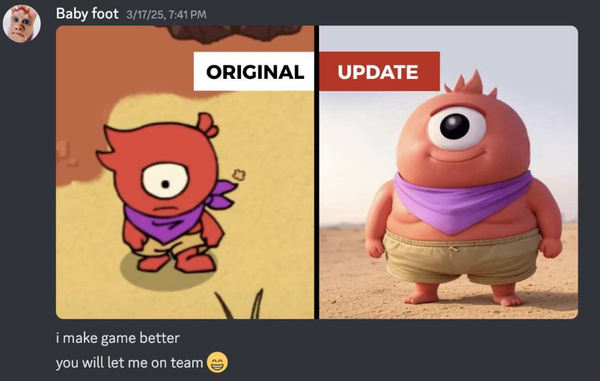Skeletal hard-liners
Also: Sopranostok, dog speedrunners, and Scorsese's movie picks.

This week, we’re remembering the internet of the 2010s while looking forward to 2300000000 AD. First, an editorial note:
We’re leaving Substack (soon)
Most of our readers have probably followed the recent Substack exodus. In short, the site’s founders have refused to moderate content on their platform, including newsletters that promote Nazism, under a “sunlight is the best disinfectant” sort of policy. This means that anyone publishing on Substack could have hateful content suggested to their readers, and anyone running payments through Substack could be supporting that content, as Substack takes a cut of all payments and maintains a shared infrastructure. In the wake of this, as well as ham-fisted responses from Substack’s founders (Hard Fork gave a good overview), newsletters like Platformer, Garbage Day, and Citation Needed have all migrated to new platforms.
We intend to do the same. It’ll take us a couple weeks — we’ve all got some other work to deal with first, and need to figure out which alternate platform makes the most sense for us. But since we haven’t turned on payments yet, we’re only costing Substack money anyway. If you have any questions or concerns, please, hit reply.
1. A YouTuber is recreating Kendrick LPs from memory
Back in 2007, the band Dirty Projectors released a curious experiment: Rise Above, a loose “cover” of Black Flag’s 1981 LP Damaged reimagined “from memory” by bandleader David Longstreth, who hadn’t listened to the album in 15 years. Critics lauded Longstreth as a “visionary” and called the record “completely f**king perfect [sic].” Little did they know that a YouTube channel named OREWAYASUKE would someday perform this same exercise on iconic rap records, recreating entire LPs in the span of a single evening with much more limited means.
At the time of writing, OREWAYASUKE has released recreations of six LPs by Kendrick Lamar and Kanye West using only overdubbed vocal tracks. Their recreations strike a balance between respectably accurate mimicry and playful corner-cutting, as in their interlude-less cover of “All of the Lights.” In other tracks, they struggle to maintain a straight face while bouncing between samples and overdubs; during the latter half of “DNA.,” for example, they succumb to fits of laughter as they yelp “Gimme some ganja!” over half-remembered lyrics. Yet what ultimately makes OREWAYASUKE’s recreations work is how surprisingly faithful they can be, demonstrating an intimate familiarity with the source material. Just listen to their take on “Bitch Don’t Kill My Vibe,” for example, which manages to incorporate elements of the Jay-Z remix. OREWAYASUKE might be the first to plant a flag on this format, given that most other music “recreated from memory” on YouTube appears to come from Undertale / Deltarune.
2. One of the hardest game trailers ever just dropped
There’s really nothing you can add to this pitch. Set in 2300000000 AD, Angel at Dusk promises to be the “uncompromisingly skeletal” game the world has been awaiting for two billion years. The previous shmups in developer Akiragoya’s trilogy are 2018’s well-regarded Steel Vampire (“hear the shrieks of colliding metal!”) and the very horny “yuri side scrolling shooting game” Maidens of a Hollow Dream.
3. Speedrun festival AGDQ headlined by dog
Awesome Games Done Quick, a charity speedrun event featuring every game under the sun, runs until Sunday. The semiannual stream is a huge event on Twitch, reaching more than 90K concurrent viewers when it kicked off this week. It’s not so much the Speedrun Olympics as a celebration of the impulse that inspired speedrunning: finding new ways to approach the games that you know better than anyone else. Already, a very well-trained Shiba Inu speedran the NES game Gyromite, someone beat Super Mario 64 using a drum set, and a longtime “Boyardposter” sort of casually played a 1996 FMV game based on French game show Fort Boyard in the early hours of the morning.
4. Remembering The Guardian’s hapless guest columnists

A Twitter thread about the funniest headlines from The Guardian’s Opinion section prompted users to reshare classics like “Why do my children find me so annoying?” For more than a decade, the section’s overheated takes and hatereads have earned it a reputation on social media as a place made to be screenshotted rather than read; online, it often overshadows the old identity of The Guardian as a bulwark of left-leaning investigative journalism. The vertical reliably gets a ton of mileage online for its “it happened to me” headlines and American Voices-style author photos (as well as the aggressively normal takes of Adrian Chiles, “the UK’s sole non-problematic columnist”), though it often appears to be throwing its own contributors to the internet wolves.
The section’s greatest hits embody a style of 2010s clickbait that now feels endangered:
- “I was being yelled at by a group of lads driving past — then they got their comeuppance”
- “I dread the day my daughter’s poos get smaller”
- “Mornings are full of terror — and turning on the radio only makes things worse”
- “My son’s tattoo hurt me deeply”
- “When it comes to sexual desirability, balls are often treated as an afterthought”
- “Tea is a national disgrace”
5. Embrace chaos: Rewatch The Sopranos on TikTok
@thesopranos “So what, no fucking ziti now?” #TheSopranos #Sopranos25 #HBO #SopranosTok Salute to 25 years of your favorite family. The Sopranos is streaming on @Max.
♬ original sound - The Sopranos
To celebrate the 25th anniversary of the debut of The Sopranos, HBO has begun uploading 25-second, vertically oriented recaps of every episode on TikTok. If you’ve watched the show a handful of times in the past quarter-century, it’s a fun way to revisit classic episodes; the edits capture the dream logic of “Funhouse” as well as the cadence of classic lines like “Next time you come heavy or not at all” or “What, no fucking ziti now?” They’ve currently uploaded edits through the second season, and it’s worth wrangling into your algorithm.
The Sopranos has long had a foothold on the platform. #Sopranostok is a sort of deranged exercise in recontextualization, taking quiet, surreal, often devastating narratives told across a dozen-plus hours and hammering them into supercuts where the point is “Christopher Moltisanti took no shit” or “Silvio took no shit.” Elsewhere the platform’s penchant for toying with speed and dadaist intercuts further skew the show. None of this is radically different from the way any other show gets transformed by TikTok fan edits and unexpected memes, but it is fun to see the way the show’s pre-internet resonance continues to refract through digital culture.
6. What happens after Pitchfork?

Conde Nast recently announced that Pitchfork would be folded into GQ as a sort of sub-brand, fulfilling the promise made in 2015 when they purchased the iconic music site due to its “passionate audience of millennial males.” They’ve also gutted the staff, including many of its news and features staffers. Perhaps the site’s best-in-class criticism and still-important Best New Music delineation will retain their influence alongside GQ’s editorial; here’s hoping. But it all speaks to an increasing lack of institutional curation of music. Spotify playlists like Rap Caviar and Mint, whose human editors were once seen as essential tastemakers, have also seen decreasing returns, according to a Bloomberg report. The platform is instead leaning more heavily into algorithmic curation and AI DJs, just as labels get increasingly desperate to do whatever it takes to find traction on TikTok. It’s obviously to the detriment of culture when capital is directed to satisfy the whims of opaque algorithms beyond the understanding of even their own creators, making human curators — like No Bells, Passion Of The Weiss, Futurism Restated, or whoever has sway in your ecosystem — the wandering ronin of a fractured music-recommendation ecosystem.
7. Beatboxer’s bizarre music video becomes internet legend
This (slightly NSFW) animated music video may be one of the most expensive pieces of self-insert erotic artwork anyone has ever commissioned. The video stars Charlie Morningstar, a character from the adult animated show Hazbin Hotel, alongside Verbal ASE, a YouTuber best-known for producing “Cartoon Beatbox Battles” between characters like Groot and Pennywise the Clown. While Hazbin Hotel is a musical show and Verbal ASE is a beatboxer, the song itself has nothing to do with either of them — it’s a 2018 song by the band SYNAPSON. To make things even stranger, Hazbin Hotel is set to premiere today, meaning this video was animated well before the show’s first season even aired.
The video enjoyed a relatively quiet and uncontroversial lifespan on YouTube since at least September of last year, but went viral after Twitter user @thestartofluck shared screenshots from Verbal ASE’s Discord this past week, alleging that Verbal ASE had paid at least $46k to get it made. Verbal ASE had just posted a video begging his fans for money to help keep “Cartoon Beatbox Battles” going last month, leading many commenters to claim — via a long-winded game of internet telephone — that Verbal ASE “went bankrupt” after spending “50k” on a music video. Verbal ASE himself has yet to comment on the incident; meanwhile, the video has spawned a meme format on TikTok and Twitter, inspiring numerous edits where either Verbal ASE or Charlie is swapped out for another character.
8. People still don’t like AI art in games

Square Enix’s upcoming shooter Foamstars is the latest game to get caught in the crossfire of AI discourse. In an interview with VGC, Foamstars producer Kosuke Okatani admits that the dev team used Midjourney for in-game album covers, though he estimates that AI-generated art makes up “0.01% or even less” of the game’s total content. Nobody online liked this, with many making unfavorable comparisons to Splatoon and allusions to Square Enix’s experiments with NFTs. The news comes days after Square Enix President Takashi Kiryu made a vague statement about being “aggressive in applying AI” to future development.
The flap is reminiscent of the criticism Rockstar faced after the disastrous launch of Grand Theft Auto: The Trilogy – The Definitive Edition. On its release, players accused Rockstar of using AI upscaling to “remaster” textures without performing proper quality assurance, resulting in a number of botched visual gags. For many players, in-game art like Minmo is evidence of a human authorial voice, a way for developers to sneak jokes into the less-visited corners of a level. Finding an AI-generated poster in a richly detailed game like Alan Wake II would only undermine its meticulous craftsmanship.
Chum Box
- Pokemon-with-guns crafting game Palworld is finally launching into Early Access today, and early impressions are surprisingly positive. Apparently it’s like Ark.
- PC Cursed, an anthology of PSX-style “analog horror” games, was released last week. Similar to The Haunted PS1’s past releases, PC Cursed is styled like a demo disc from a haunted copy of PC Gamer circa 1998, complete with a DIY printable magazine.
- In an interview, Yasiin Bey (formerly Mos Def) said that Drake’s music is made for shopping at Target, a killshot that will probably follow both emcees for a decade. This is actually a kind of fun beef; both rappers thrive with good material.
- Thank Killers Of The Flower Moon for getting Martin Scorsese out on the media circuit: this Letterboxd interview (with Leonardo DiCaprio) is full of interesting chestnuts.
- Davigo is an asymmetric multiplayer game where giant VR players battle teams of up to four tiny PC players. Non-VR users play for free, which feels like some kind of “Ladies Night” promo.
- The cutscenes from 2005’s Japanese nanobot-action-horror game Nano Breakers feel like a lethal dose of liquid PS2. (via Cruelty Squad dev @villekallio)
- A Cruelty Squad modder recently made a level set on a moving train, which is a feat given the oddities of the game. The CS mod hub that indexes it, located on Geocities tribute platform Neocities, is also a work of art.
- A video from rapper Lil Ugly Mane offered a vision of the future of AR: “the YouTube in my toilet won’t load.”
- “I killed Milhouse.” - AI Homer Simpson (evil rap version)
- This photo of a Half Life 2-coded balcony is likely the closest we’ll get to IRL Ravenholm.
- Brace yourself for one of the most unhinged mobile ads we’ve seen.
That’s it for this week. We’ll be thinking about Minmo until next week.






